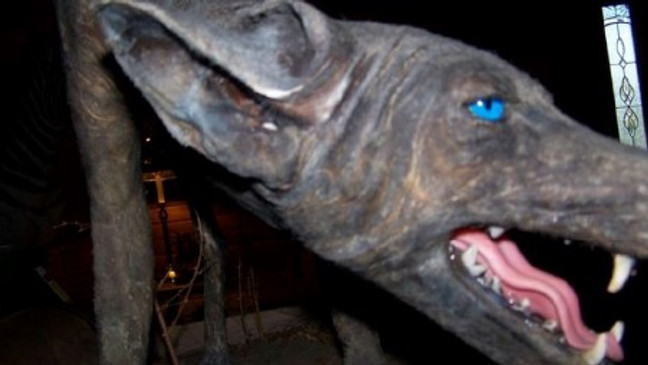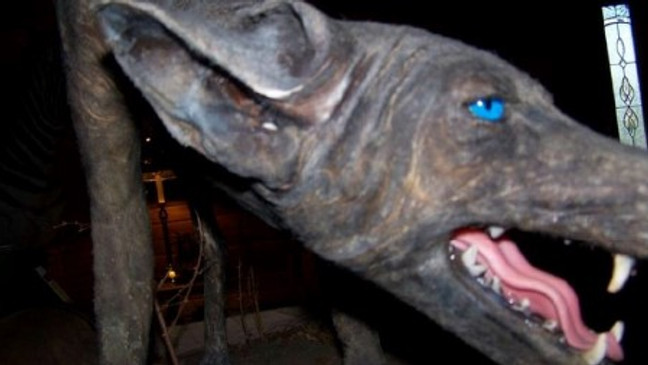The Chupacabra, a name that hails from Spanish and translates to “goat-sucker,” has for decades been a subject of intense debate, curiosity, and mystery. The burning question on many minds is, “Is the Chupacabra real?” Tales of the Chupacabra began in Puerto Rico in the 1990s, when reports emerged of livestock, mainly goats, found drained of blood with peculiar puncture wounds. Since then, sightings and claims have spread throughout Latin America and even into parts of the U.S.
To ascertain the reality of the Chupacabra, one must delve deep into the evidence. While countless eyewitness accounts have described the creature as a reptilian beast with spikes or quills running down its back, others have painted it as a hairless, dog-like creature. These varied accounts make it challenging to pinpoint a singular, defining characteristic of the supposed beast. Moreover, most alleged Chupacabra carcasses that have been examined turned out to be animals suffering from mange or other illnesses, rather than any unknown creature.
Science and skepticism often intersect when discussing the existence of such legendary creatures. Most scientists and wildlife experts have expressed doubts about the Chupacabra’s existence, attributing the phenomena to misidentifications, hoaxes, or simple folklore. Yet, for many, the Chupacabra remains a symbol of the unknown and the power of oral tradition. Whether the creature is real or merely a product of imagination and legend, the fascination with the Chupacabra reflects our collective intrigue with the unexplained mysteries of our world.
What is the Chupacabra?
The Quest for Reality: Is the Chupacabra Real?
The Chupacabra, often referred to as the “goat-sucker” when translated from Spanish, is a creature steeped in mystery and folklore. Central to many discussions and debates is the overarching question, “Is the Chupacabra real?” Originating from Puerto Rico in the 1990s, stories surrounding the Chupacabra detailed livestock, predominantly goats, being discovered drained of blood with distinct puncture wounds. These accounts sparked interest and soon reports claiming Chupacabra sightings spread not just within Latin America but ventured into the U.S. territories as well.
Diving deep into the quest of determining the Chupacabra’s reality, the evidence presented is indeed diverse. Numerous eyewitnesses claim to have seen the creature, describing it as a reptilian entity with spines or quills along its back. In contrast, others believe the Chupacabra resembles a hairless canine creature. This variety in descriptions poses a challenge: Is the Chupacabra real, or is it a figment of collective imagination? Most purported Chupacabra remains analyzed by experts were identified as familiar animals with diseases like mange, rather than an uncharted beast.
Scientific scrutiny into the Chupacabra’s reality has often intersected with skepticism. The majority of scientific and wildlife professionals lean towards skepticism regarding the Chupacabra’s existence, suggesting that misidentifications, folklore, or even hoaxes might be behind the tales. Yet, for many believers and enthusiasts, the question of “Is the Chupacabra real?” remains unanswered, symbolizing the allure of the unknown.
In sum, while the evidence might lean toward skepticism, the Chupacabra’s legacy as a legendary creature remains. The persistent question, “Is the Chupacabra real?” epitomizes humanity’s enduring fascination with mysteries, legends, and the desire to understand the inexplicable in our vast world. Whether fact or fiction, the Chupacabra’s story continues to captivate and inspire intrigue across generations.

This image is property of thehappinessfxn.com.
Description of the Chupacabra
Unraveling the Enigma: Is the Chupacabra Real?
The Chupacabra, a name that resonates with mystique, is often described as a creature of strange and uncanny features, leading many to ask, “Is the Chupacabra real?” With a distinctly reptilian appearance, those who claim to have seen it paint a vivid picture. Witnesses steadfastly attest that the Chupacabra stands somewhere between three to five feet tall, and its scaly skin shimmers under moonlight. Its large, glowing red eyes are said to pierce the darkness, while its sharp fangs hint at its predatory nature.
The Chupacabra’s body structure is often likened to a fusion of a kangaroo and a lizard, an oddly bipedal creature navigating its surroundings with ease. Adding to its already enigmatic aura, certain accounts ascribe wings to the Chupacabra, suggesting it has the capacity to glide silently against the backdrop of the night sky.
The very descriptions of the Chupacabra raise eyebrows and skepticism. Yet, they also highlight a shared curiosity: Is the Chupacabra real, or is it a tapestry woven from fear, myths, and the human penchant for the inexplicable? Regardless of its factual existence, the narrative surrounding this cryptid showcases our timeless attraction to the world of the unknown.
The Evolution of Chupacabra Sightings: Is the Chupacabra Real?
The Beginning: Early Sightings of the Chupacabra
The earliest records surrounding the enigmatic Chupacabra trace back to Puerto Rico. During these initial years of the Chupacabra phenomenon, a torrent of sightings emerged, painting the island with a mix of fear and intrigue. Witnesses bravely shared their harrowing encounters, detailing the sheer terror they experienced when confronting this baffling creature. As word spread like wildfire, the phenomenon wasn’t limited to Puerto Rico. Soon, tales of similar chilling attacks and sightings echoed in other Latin American countries, including Mexico and Chile. Each account seemed to bolster the pressing question: Is the Chupacabra real?
A Continued Mystery: Recent Sightings and Encounters
Although the fervor from the initial sightings began to wane, the Chupacabra’s legacy persisted. Reports of newer sightings continue to emerge even today. A notable example is in the United States, particularly in Texas, where puzzled farmers have stumbled upon animal carcasses, mysteriously drained of their life essence. Such contemporary encounters have not only stoked the flames of the initial interest in the Chupacabra but also ushered in a renewed wave of investigations. The lingering presence of these accounts reinforces the age-old question of the Chupacabra’s reality.
Voices from the Shadows: Witness Testimonies
Central to the enduring mystery of the Chupacabra are the testimonies of those who claim to have witnessed it firsthand. These individuals, their voices often tinged with a mix of fear, wonder, and bafflement, offer a deep dive into their personal experiences with the creature. Their detailed renditions not only shed light on the Chupacabra’s supposed physical attributes but also its behavior and the aftermath of its rumored attacks. While skeptics raise eyebrows, questioning the authenticity of these narratives, believers clutch onto these testimonies, seeing them as precious pieces of evidence, further deepening the debate: Is the Chupacabra real?
Each chapter in the story of the Chupacabra, from its earliest sightings to the most recent encounters and the poignant testimonies of witnesses, adds layers to its enigma. The consistent pulse of these tales, over years and across borders, keeps the question alive, ever burning and ever elusive.
This image is property of cbsaustin.com.
Mysterious Animal Attacks
The Predator’s Modus Operandi: Chupacabra as a Predator
Often cloaked in the shadows, the Chupacabra has earned its reputation as a formidable and enigmatic predator. Preying predominantly on domesticated livestock, its hunting style is unlike any known creature. The Chupacabra’s signature approach involves meticulously draining its prey’s blood, evident from the puncture marks that mar the victim’s body. Disturbingly, it abstains from consuming the flesh of its victims. This selective feeding pattern intensifies the mystery around its behavior and deepens the question: Is the Chupacabra real or a figment of collective imagination?
The Unmistakable Evidence: Characteristics of the Animal Attacks
Chupacabra-linked animal attacks are set apart by a unique set of characteristics, making them distinctly different from common predator strikes. The eeriness of these incidents lies in the lack of signs of a struggle, pointing towards a predator that is both swift and deadly efficient. Moreover, the consistent puncture wounds, often found around the neck or chest region, underscore the precision and methodical nature of the attacks. These atypical features fuel speculation and wonder about the presence of a creature with unparalleled predatory prowess.
Sightings and Shadows: Correlation with Chupacabra Sightings
Adding another layer to the Chupacabra enigma is the apparent correlation between its sightings and the surge in mysterious animal fatalities. Areas reporting Chupacabra encounters often witness an uptick in the number of animals found devoid of blood. This connection between eyewitness accounts and a spate of bizarre attacks lends credence to those who believe that the Chupacabra is more than a mere mythical figure.
In piecing together the puzzle of the Chupacabra, from its predatory habits to the unique characteristics of its alleged attacks and the overlapping timelines of sightings, one can’t help but be drawn into the compelling narrative. Whether real or legendary, the Chupacabra continues to capture the imagination and provoke debates about the known and unknown facets of our world.
Explanations and Theories
Grounded in Biology: Biological Explanations
Diving into the realm of science, some researchers believe that the answers to the Chupacabra phenomenon lie in biological explanations. A prevailing theory postulates that these reported encounters could be attributed to a mutated or hybrid species, perhaps a canine variant or a feral dog exhibiting unusual physical attributes and hunting behaviors. By aligning the Chupacabra’s characteristics with known biological principles, this perspective seeks to demystify the creature through a lens of rationality.
Hidden Creatures: The Cryptozoology Theory
Navigating the gray area between the known and the unknown is the field of cryptozoology. Advocates of this discipline present the Chupacabra as an enigmatic creature that, while not yet identified, may eventually find a place in the annals of zoology. They argue that many cryptids once dismissed as mere legends or hoaxes have, over time, been verified and accepted by the broader scientific community. Could the Chupacabra eventually join these ranks?
Visitors from the Stars: Extraterrestrial Theories
Dipping into the cosmos and the possibilities of life beyond Earth, extraterrestrial theories introduce the Chupacabra as a visitor from another world. Proponents posit that the creature’s odd physicality and its seemingly elusive nature resonate with common notions about alien beings. While this perspective might stretch the boundaries of belief for many, it underscores the Chupacabra’s ability to stoke the fires of wonder and imagination.
Beyond the Veil: Paranormal Theories
Treading the path of mysticism and ancient legends, some attribute the Chupacabra phenomenon to the realm of the paranormal. Equating the creature with demonic or supernatural entities, these theories draw inspiration from mythological accounts present across diverse cultures. By viewing the Chupacabra as a manifestation of age-old beliefs and tales, this perspective anchors the creature in the depths of human intrigue with the ethereal and unexplained.
In examining the Chupacabra, what’s evident is the range of interpretations, from the scientific to the supernatural. Each theory, in its own right, speaks to the enduring allure of the creature and humanity’s insatiable quest for understanding the uncharted mysteries of our universe.

This image is property of upload.wikimedia.org.
Scientific Investigations
Official Scrutiny: Investigations and Reports
As whispers and tales of the Chupacabra began to gain traction, it wasn’t long before government bodies and reputable scientific institutions felt the need to intervene. These entities embarked on official investigations, aiming to shed light on the phenomenon that had captured the public’s imagination. However, their endeavors were often met with obstacles. The evasive nature of the creature, coupled with a scarcity of tangible evidence, meant that solid conclusions remained elusive. Despite thorough investigations and considerable resources, definitive proof of the Chupacabra’s existence remains a matter of debate.
Examining the Physical: Analysis of Alleged Chupacabra Remains
Throughout the years, several instances have stirred excitement and curiosity—discovery of alleged Chupacabra remains. Eager to find answers, experts have closely examined these remains, which have varied from peculiar-looking animal bodies to skillfully crafted taxidermy specimens seemingly designed to fuel the legend. Unfortunately, more often than not, these evaluations have ended in disappointment. The remains, upon close scrutiny, have been identified as belonging to known animal species or debunked as fraudulent endeavors aimed at perpetuating myths.
Unlocking Genetic Secrets: DNA Testing
The advancements in DNA analysis techniques have breathed new life into the quest for the Chupacabra’s truth. With the ability to dive deep into genetic material, some researchers have managed to secure DNA samples from carcasses believed to be victims of the creature. Their hope: that these samples might hold the key to proving the existence of the elusive Chupacabra. Regrettably, the results have yet to deliver the breakthrough many have yearned for. While the tests have revealed the origins of many samples, none have provided indisputable evidence of a distinct Chupacabra species. Thus, the pursuit for genetic confirmation remains ongoing.
In this enduring enigma of the Chupacabra, what stands out is the rigorous effort by various entities to ascertain the truth. From official probes to genetic analysis, the journey to unravel the mystery is marked by both skepticism and hope. Whether the Chupacabra will one day be categorized as fact or fiction remains to be seen.
Hoaxes and Misidentifications
Debunked Tales: Famous Chupacabra Hoaxes
The allure and mystique surrounding the Chupacabra legend have, unfortunately, also been a fertile ground for deception. Over the years, the Chupacabra name has been invoked in various hoaxes. Ambitious individuals, driven by motives ranging from seeking attention to financial gain, have come forth with bold claims of capturing or even killing these elusive creatures. However, upon close scrutiny and investigation, many of these assertions crumble, revealing them as nothing more than elaborate fabrications. Such hoaxes, while capturing temporary media attention, have the unintended effect of tarnishing the credibility of genuine research into the Chupacabra phenomenon. They also cast shadows of doubt, complicating the already challenging quest to differentiate fact from fiction in the world of cryptozoology.
When Known Meets Unknown: Cases of Misidentifications
In the vast landscape of alleged Chupacabra sightings, many accounts can be traced back to simple cases of misidentification. For instance, canids afflicted by conditions like mange present with symptoms that alter their appearance, leading to bald patches and skin irregularities. Such visual alterations can cause them to be mistaken for the mythical Chupacabra, especially when viewed from a distance or under limited lighting. Likewise, certain avian predators—such as owls or vultures—are known to leave puncture-like marks on their prey due to their feeding habits. These marks can be eerily reminiscent of the ones attributed to the Chupacabra, further fueling misidentifications.
The journey through the world of the Chupacabra is undeniably fascinating, but it’s one riddled with pitfalls of deceit and genuine mistakes. It underscores the importance of approaching such phenomena with a balance of curiosity, skepticism, and rigorous scientific methodology. Only by sifting through the amalgam of truth and fallacy can we hope to inch closer to understanding the reality of the Chupacabra.

This image is property of shoppersvila.com.
Cultural Impact and Popularity
From Screens to Pages: Chupacabra in Popular Culture
The Chupacabra, with its enigmatic background and eerie descriptions, has transcended its cryptic origins to claim a significant spot in mainstream popular culture. Cinema has portrayed the creature in diverse ways, sometimes as a menacing antagonist, while at other times, a misunderstood being. These cinematic representations are a testament to the creature’s adaptability and appeal. Similarly, the gaming industry has embraced the Chupacabra, often using its mysterious aura as a backdrop for adventurous quests or challenges. Moreover, literature, ranging from children’s books to mature horror novels, has incorporated the Chupacabra, crafting tales that tap into the primal human fascination with the unknown. This multifaceted presence across various media outlets speaks volumes about the Chupacabra’s lasting allure and its status as one of the most iconic cryptids in contemporary culture.
Tales of Old and New: Chupacabra in Folklore and Legends
Stepping back from modern media and delving into ancient traditions, we find the Chupacabra seamlessly blending into folklore and legends of different cultures. While its reported sightings trace back only a few decades, the rapid integration of the Chupacabra into global mythologies is impressive. From campfire tales to age-old rituals, communities have adopted and adapted stories of this creature to fit their cultural narratives. Such deep-rooted connections, combined with the oral and written traditions of various societies, ensure that the legend of the Chupacabra remains vibrant. As stories evolve and adapt, the Chupacabra’s place in folklore continues to solidify, promising that its tale will be passed down, reimagined, and retold for many generations to come.
Public Belief and Skepticism
Evidence and Faith: Believers’ Arguments
For those who believe in the Chupacabra’s existence, the sheer volume and consistency of witness testimonies can’t be merely coincidental. These believers stand firm, drawing attention to the multiple reports of firsthand encounters with the creature. Furthermore, they underline the pattern that emerges when correlating Chupacabra sightings with the discovery of unexplained animal attacks. For them, it isn’t mere happenstance but indicative of the creature’s presence.
Beyond empirical evidence, believers also emphasize the cultural and historical gravitas of the Chupacabra legend. Spanning across countries and generations, the tales of this cryptid have found a place in the collective psyche of many communities. Believers posit that such a widespread and persistent legend must be grounded in some form of truth. In their view, to dismiss these diverse and recurring accounts without proper investigation would be to neglect a potentially significant piece of our natural world’s puzzle.
Questioning and Reason: Skeptics’ Explanations
On the other side of the debate stand the skeptics, armed with a methodical and analytical approach. Skeptics delve into the psychology of human perception, pointing out that eyewitness testimonies, while compelling, are susceptible to various biases, memory distortions, and the influence of existing beliefs or fears. The potential for misidentifying known animals, especially those suffering from diseases or deformities, offers a plausible explanation for many reported sightings. This argument is further bolstered by the recurring theme of mistaking diseased canids, such as mangy coyotes, for the legendary Chupacabra.
Beyond witness accounts, skeptics also highlight the conspicuous absence of tangible evidence. They question why, in an age of smartphones and advanced technology, definitive proof—like clear photographs or DNA evidence—remains elusive. In their eyes, the gaps and inconsistencies in the available data weaken the claim of the Chupacabra’s existence.
The debate around the Chupacabra is emblematic of the larger tension between folklore, personal experiences, and empirical evidence. As stories of the Chupacabra continue to emerge, this debate is likely to persist, reflecting humanity’s enduring struggle to define the boundaries between myth and reality.

This image is property of cbsaustin.com.
Alternative Explanations
Nature’s Usual Suspects: Local Predators Mistaken for Chupacabra
The mystery of the Chupacabra often intertwines with the natural world. Some experts believe that the key to understanding this phenomenon lies not in the realm of the unknown but in recognizing the animals that are already familiar to us. Local predators such as coyotes, feral dogs, and other wild animals might sometimes exhibit unusual behaviors or physical appearances due to diseases or mutations. Such anomalies can make these animals seem alien or otherworldly to the untrained eye.
When combined with the backdrop of regional myths and whispers of the Chupacabra, it’s not hard to see how an ordinary animal might be cast in a more sinister, mysterious light. These local predators, especially when affected by conditions like mange that alter their appearance, could be responsible for the sporadic incidents of livestock attacks. As these animals go about their predatory instincts, the folklore-fueled lens through which some view them might transform them into the dreaded Chupacabra.
Mind Games: Psychological Factors Influencing Sightings
The human psyche is a complex web of beliefs, emotions, and perceptions. When it comes to mysteries like the Chupacabra, our minds can sometimes be our own most potent adversary or ally. Various psychological factors can distort or amplify our interpretation of what we see or believe.
Cultural conditioning, for instance, can shape our expectations and perceptions, causing us to see what we’ve been conditioned to expect rather than what truly is. Similarly, mass hysteria, fueled by sensational media coverage or community fears, can lead to a spike in reported sightings, even when the actual evidence is scant.
The suggestibility of the human mind, particularly when exposed to popular representations of the Chupacabra in movies, books, or television, might further bolster these beliefs. A shadow in the dark or an unexplained noise can quickly be attributed to the infamous creature, especially when one’s mind is already primed by cultural tales and media portrayals.
This intersection of psychology and folklore provides a fascinating lens through which to view the Chupacabra phenomenon. The creature stands not just as a symbol of the unexplained but also as a testament to the intricate ways our minds can shape, and be shaped by, the stories we tell and believe.
One alternative explanation suggests that regional predators, such as coyotes or feral dogs, may be mistaken for the Chupacabra due to certain similarities in appearance and hunting patterns. These creatures could potentially account for the animal attacks attributed to the Chupacabra in different regions.
Psychological Factors Influencing Sightings
Psychological factors can play a significant role in the perception and interpretation of mysterious phenomena. This explanation proposes that the Chupacabra sightings may be influenced by cultural beliefs, mass hysteria, or even suggestibility triggered by popular media representations of the creature. These psychological factors might contribute to the widespread belief in the Chupacabra, despite the lack of concrete evidence.
The Unanswered Questions
Elusive Truths: The Lack of Concrete Evidence Surrounding the Chupacabra
A pressing dilemma in the study of the Chupacabra is the conspicuous lack of concrete evidence substantiating its existence. Although the Chupacabra remains a recurrent topic of fascination, with countless alleged sightings and a plethora of anecdotes, definitive evidence like unambiguous photographs, indisputable DNA results, or an actual captured specimen remains absent. This stark void of tangible proof intensifies the enigma of the Chupacabra, fueling both skepticism and belief. The question, “Is the Chupacabra real?” becomes even more complex when confronted with this lack of empirical evidence.
Advancements on the Horizon: Future Research and Investigations into the Chupacabra
Yet, the pursuit of the truth about the Chupacabra persists. Future investigations promise renewed hope in uncovering the riddle that the Chupacabra presents. With technology ever-advancing, there are emerging tools that might one day provide clarity. DNA analysis is becoming more sophisticated, potentially allowing researchers to discern the Chupacabra’s genetic blueprint should a credible sample arise. Additionally, surveillance and tracking technologies might capture the creature in action, providing visual evidence where eyewitness accounts fall short. The collaboration between dedicated scientific communities and passionate cryptozoology enthusiasts could forge a pathway towards unveiling the reality of the Chupacabra, or debunking it once and for all.
Final Thoughts: The Lasting Legacy of the Chupacabra Mystery
In conclusion, the Chupacabra stands as a testament to human curiosity, fear, and the allure of the unknown. With its purported reptilian visage, claims of nocturnal predation, and vivid accounts from alleged witnesses, the Chupacabra’s enigmatic presence in popular discourse is undeniable. Scientific endeavors offer avenues for insight, yet the question, “Is the Chupacabra real?” remains unresolved. The lack of concrete evidence either confirming or refuting the Chupacabra’s existence only deepens its allure. As we look to the future, we can only hope that emerging research and technological innovations might one day unveil the truth behind this captivating mystery.
Get your spiritual protection salt here!
- How Psychic Surgery Claims To Heal Without Incisions
- The Quest For A Consistent Theory Of Ghosts
- Calvine UFO Mystery: Aurora Spy Plane Linked to UK’s Roswell
- UFOs and the attempted assassination of Donald Trump
- How Psychics Use Shotgunning To Deceive Their Audiences
- Vanished Without a Trace: Mystery of William and Margaret Patterson
- Parapsychology & The Study Of Psychic Phenomena
- The 7 Most Realistic Ghost Movies Of All Time
- MOTHMAN in Central Ohio? Witness Reports Unexplained Sighting!
- Was it a Whale or CRYPTID SEA CREATURE in the South China Sea?
- LARGE, LANKY PALE 'CREATURE' Encountered, Later Vanishes, in Northumberland County, Pennsylvania
- TALL, THIN HUMANOID ENCOUNTERS Reported in Hebbronville, Texas
- WHAT DID I SEE? Was it Living or a Manifestation?
- S1.E1. Passing the Baton | The Stumbling Spirit Podcast
- S1.E2. Soul Awakening | The Stumbling Spirit Podcast


